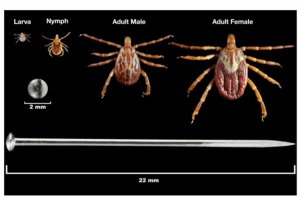What Justin Bieber Wish he Knew.
I’m going, to be honest with you all, I never thought I’d find myself writing about Justin Bieber. But hey, it’s 2020 and we live in an unpredictable world.
You may have heard the news that Justin Bieber has Lyme Disease (bet you didn’t think I kept up with celebrity gossip!?). Lyme Disease is the most common tick-borne disease in the United States. More than 30,000 people in America are diagnosed with Lyme Disease every year. In fact, according to the University of Florida, of the Lyme disease cases reported from 1999-2008, 30 percent were acquired in our home state. I also recently heard of a potential Lyme disease case in Merritt Island.
I’ve received many questions from parents about ticks and how to prevent them, so wanted to share all that I know about the nasty little buggers. *Before diving in, if you think you or someone you know has a tick bite, please consult a healthcare professional.
1. How to identify a tick
There are many varieties of ticks, but all ticks are extremely small and have eight legs like a spider (they belong to the arachnid class). The larvae are as small as a grain of salt, the nymphs can be as small as a pinhead, and the adults as small as a pencil eraser. This makes it annoyingly difficult for the human eye to notice. Ticks are blood-sucking little vampires and will get larger as they suck more blood.
Source: Centers for Disease Control
According to the Florida Department of Health, the following ticks are the ones predominantly found in our state and that can spread illness:
- BLACKLEGGED TICK, also called a deer tick. This tick takes the blame for a majority of Lyme disease cases.
- LONE STAR TICK: This tick does not transmit Lyme disease, but can transmit other pathogens.
- AMERICAN DOG TICK, also called a wood tick. You guessed it, this tick is primarily found on dogs but can also be found on larger mammals such as horses, cattle, or even humans.
- GULF COAST TICK: This tick can be found in grass prairies and coastal uplands aka the Florida Gulf Coast is a breeding ground for them.
- BONT TICK: Although this tick is not from Florida, it may be brought in from the Caribbean.
If you’d like more detailed information from the Florida Department of Health or the University of Florida, it can be found here and here.
2. Know the difference between a tick bite and a regular bug bite
A question I often get is how can you tell the difference between other bug bites and a tick bite? Sometimes you can’t. Some people only notice their tick bites because they found the tick still attached to their body sucking blood. According to iGene, Inc, the leading testing lab for Lyme Disease, here are the main tick bite identifiers:
- Tick bites are not fluid-filled, whereas bites from ants and other insects are typically pus-filled.
- Location can sometimes help distinguish tick bites from other insect bites because ticks most commonly bite the back of the neck, scalp, groin, and legs.
- Other insect bites may be multiple in number. Ticks typically bite once then burrow their head under the skin.

3. What to do if you have a tick bite
If you do find a tick attached to your body, the best thing to do is remove it immediately. According to the National Institute of Health, the sooner you remove a tick, the better. It takes time for infections to reach a person’s bloodstream, especially Lyme disease. A tick needs to remain attached for 36 hours before Lyme disease can be transmitted, so remove any ticks as quickly as you can.
It may sound weird but you should also preserve the tick to help your doctor determine whether it carries a potential disease. You can remove the tick yourself with a tick removal tool or with a set of tweezers.
See the step by step process to remove and preserve a tick from Healthline:
- Grasp the tick as close as you can to your skin’s surface.
- Pull straight up and away from the skin, applying steady pressure. Try not to bend or twist the tick.
- Check the bite site to see if you left any of the tick’s head or mouthparts in the bite. If so, remove those.
- Clean the bite site with soap and water.
- Once you’ve removed the tick, submerge it in rubbing alcohol to make sure it’s dead. Place it in a sealed container.
- See your doctor as soon as possible to find out if any treatment is necessary based on the type of tick that bit you. These steps were medically reviewed by Judith Marcin, MD.
4. Know the top tick symptoms
If infected with a tick-borne illness, symptoms generally start to present themselves a few days after the bite. However, the general signs to watch out for include the following:
- Mild itching
- The reddened area on the skin
- The very specific type of bulls-eye rash (EM) for Lyme
- Non-EM rash for other tick-related infections
- Fever
- Vomiting, diarrhea
- Headache
- Lack of appetite
- Muscle aches, joint pain
- Confusion
5. How to avoid tick bites and tick-borne diseases
Ticks love wooded and grassy areas. For instance, ticks' favorite places are shrubs, lawn piles, weeds, and swamps. Anywhere that it might be easy for them to hop and latch on to an animal or human for feeding.
Here are some tips to avoid ticks:
- Remove ticks from pets and people as soon as noticed.
- In tick-infested areas, keep clothing buttoned and tucked in, including placing pants inside boots.
- Wear light-colored clothing to easily spot ticks.
- Apply repellents to uncovered skin.
- Avoid touching plants in tick-infested areas.
- Walk in the center of trails
- Check for ticks after frequenting tick-infested areas.
- If you live in wooded areas, check for ticks daily.
- Clear brush along pathways and frequented areas.
- The landscape for tick-free zones. I’d be happy to help provide guidance on this.
I hope this overview is helpful. Feel free to leave a comment with questions, but above all please use the resources linked in this post for any additional or detailed health information. If you think you’d like to learn how Green Wing can help you with a tick problem, check our pest services page or give us a call.
Glad we had this tick talk!
Your bug guy,
Jeff

